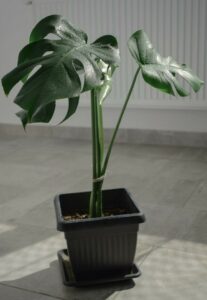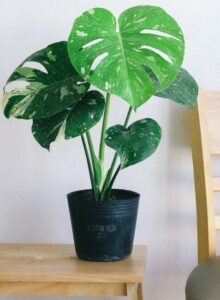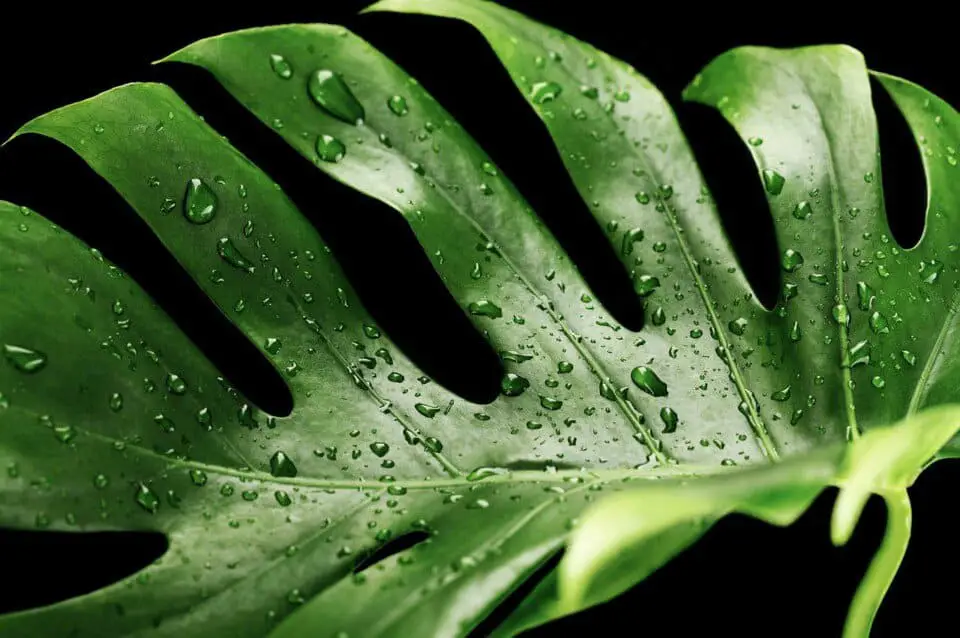Some links in the post are affiliate links and I get a commission from purchases made through some links found in the post.
Monstera plants are a great indoor houseplant. The plant’s cheese-like leaves and ability to thrive in tropical conditions make it a strong contender in the current indoor gardening craze.
Due to its remarkable resistance to water and direct sunshine, the monstera plant is a wonderful asset in one’s collection of plant species. It can be an obstruction, just like any other plant. The “Leaf Curl,” as it’s known.
Curling of Monstera leaves is primarily caused by water or heat stress; these are the two most common culprits.
There is a possibility that this is due to poor water quality, an infectious condition, or an insect infestation. Curled monstera leaves are a sign of poor lighting and excessive moisture.
For example, you must investigate if the leaves of your Monstera plant curl. However, this will allow you to deal with the root cause of the problem rather than just applying a band-aid solution that may worsen the situation rather than improve it.
Remember that curled monstera leaves are a sign that your plant isn’t getting the care it needs. I know you need more information about it. So keep reading the article to learn more about monstera leaves curling.
What Is the Curl of the Monstera Leaf?
 Monstera plants are well-known for their large, exquisite, and fenestrated leaves.
Monstera plants are well-known for their large, exquisite, and fenestrated leaves.
However, those leaves can be fragile, and if a monstera is dissatisfied with something about its surroundings or care, the first place you’ll see difficulties is on the leaves!
In most cases, monstera leaves will curl to minimize the water lost by transpiration and reduce the amount of exposed surface area.
Although this typically denotes a problem with water loss caused by a factor such as heat stress, underwatering, damaged roots, or fluid loss caused by insect infestation. Heat stress is one of the most common causes.
Is the Curling of Monstera Leaves Normal?
Monstera leaves that have begun to curl are typically an indication of a problem that is easily fixable.
You can improve the condition of your Monstera leaves Curling by adjusting to the surrounding conditions. However, if it is disregarded, there is a risk that it could prove fatal.
Curling Monstera leaves can be caused by a wide variety of factors, including the ones that are listed below.
- Aging Transplanting Shock.
- Underwatering of brand new leaves.
- Use of excess fertilizers and other chemicals etc.
Why are your Monstera Leaves Curling?
Check the soil to see whether it appears too damp or too dry before continuing your investigation into why the leaves on your Monstera plant are curled or why they are so little.
You are responsible for checking and seeing that your monstera is provided with sufficient room and indirect light to develop properly. In addition, you need to inspect to see if there are any indications of pests or diseases.
Anything that promotes water loss or inhibits plants from absorbing the necessary quantity causes the curling of Monstera leaves. To make it easier to implement, I’ll go over each potential cause to make it easier to implement.
Underwatering
When Monstera leaves curl, it’s usually because of this. Monster leaves curl if they don’t obtain enough water to perform their normal physiological functions. When it comes to the shortage of water, how can you be sure?
Observe the potting soil for browning leaves, crispy leaf margins, or brown tips if the soil is dry.
If you find any of these clues, you may be confident that you have underwatered your monster. You can also feel the pot’s weight to see if it’s dry; a lighter pot means it’s dry.
However, your monstera conserves water and ensures its existence by using a natural defensive mechanism when submerged.
Monstera leaves Curling the leaves minimizes the surface area available for evaporation (the process by which the plant loses water).
Overwatering
After watering for a week, if the soil is still damp, the water may become stagnant and suffocate root systems.
The root system will be deprived of oxygen because water molecules have taken up residence in the soil pores. The Monstera won’t be able to take in nutrients or oxygen as a consequence. If you do this, your plant’s leaves will begin to curl.
Because stagnant water provides perfect conditions for the growth of fungal diseases such as root rot, the root system fails to supply nutrients and water to the plant’s other parts when your monstera is infected with root rot.
Chemicals in City Tap Water
Chlorine and fluoride are mixed into city water and tap water. These chemicals are used to eliminate germs in the water.
Daily use of this water puts the good bacteria in the soil in danger of being wiped out. These microbes are beneficial to your monstera plant since they help break down organic debris and release nutrients to the roots.
When you water your monstera with tap water regularly, salts build up and harm the root system. Your monstera’s normal physiological function will eventually be disrupted. As a result, the leaves of your favorite monstera plant will curl.
Over Fertilization

When raising monsters in a container, this is essential to know. I believe that the fertilizer doses listed on packages are more than necessary. When your plant forms new leaves and buds, it requires more nutrients.
It is the stage of development. Most plants, including monstera, do not require fertilization in the winter.
Overfertilization can be fatal if you are too gentle with your monstera. Overfertilization damages or burns the roots. Then you may notice symptoms such as foliage curling.
Low Relative Humidity
Low humidity is another factor that may cause the leaves of your monstera plant to curl. If you have temperature control in your home, you may still have this issue even if you reside in a region with moderate humidity.
It may be advantageous to place your plant on a humidity tray or set up a humidifier nearby to keep the leaves flexible and malleable since heating and cooling systems tend to make the air quite dry.
Also, your plant should never be placed near a vent for heating or air conditioning, a fireplace, or a space heater. (All of those are guaranteed to result in crinkled and brittle leaves!)
If you have a monstera plant and are concerned that the humidity level in your home may be too dry for it, you can use this convenient humidity meter to find out for sure so that you can make the necessary adjustments.
Compacted Soil or Wrapped Roots
Your monstera may exhibit symptoms of dryness such as crispy brown spots and curling leaves, as well as symptoms of overwatering such as dark-brown spots and mushy stems if the roots of your monstera are tightly wrapped or if the soil in the pot is hard and compacted.
Both of these conditions can cause the soil to become hard and compact. These symptoms can be caused by either dryness or overwatering.
In addition to this, this occurs as a consequence of the fact that when soil is compacted, it does not easily absorb water (which leads to underwatering).
It does not drain after it has absorbed water (which leads to overwatering and even root rot). Additionally, if the roots are wrapped, it may be difficult for the plant to get water and nutrients from the soil where it is growing.
However, the solution to this problem is to repot your monstera into new well-aerated, clean soil. A pot should have a root ball inside of it that is at least two to three inches broader than the pot itself.
Pest Problem
The plant’s stems and foliage are vulnerable to assault from mealybugs, spider mites, and thrips, which feed on the plant’s fluids. This may cause the foliage to wilt and curl as a result.
Because of their small size and the fact that they are easily overlooked, spider mites can be hard to find, but if you look closely, you will be able to find them and other types of pests.
Examine the leaves carefully for the presence of any yellow spots or rings that are growing in an atypical pattern. Although this is one of the sure symptoms that unwanted bugs are feeding on your plant.
Too Small Pot
The leaves of your Monstera plant may become crinkled if it grows in a container that is too small for them. However, this condition occurs when the plant uses up all available water too quickly.
This could also cause the plant to become highly rootbound, making it very difficult to satisfy its demand for the amount of water it needs.
Anthracnose:
Monstera plants are susceptible to this disease, which is caused by fungi. However, curling and yellowing monstera leaves are two primary signs that will become apparent to you as the disease progresses.
Your Monstera’s leaves will wilt and turn brown as the infection spreads around the plant’s edges, which will cause the leaves to curl downward.
If the condition is not properly treated, the browning will expand inwards, which will result in the death of the entire leaf and, finally, the entire plant.
New Growth
 There may be more than one cause for concern regarding the leaves of the Monstera leaves curling. Specifically, if you see fresh Monstera leaves curling, this may indicate that the plant is growing new leaves.
There may be more than one cause for concern regarding the leaves of the Monstera leaves curling. Specifically, if you see fresh Monstera leaves curling, this may indicate that the plant is growing new leaves.
The leaves of the monstera plant are initially curled, but as the plants mature, the leaves gradually straighten out.
It is critical to research the curling leaves to establish whether this behavior is indicative of new growth or a cause for concern.
Is it Possible to Straighten out Monstera Leaves that have Become Curled?
Curled Monstera leaves can be fixed, but the repair’s success depends on the damage’s nature and severity. There are a few explanations for why monstera leaves curl.
If you can get control of the source, the leaves will straighten out if your Monstera plant has been submerged in water for an extended period, the best way to help it recover.
These kinds of problems require immediate attention and resolution. As soon as you see the edges of your Monstera leaves curling inward, it is time to take action.
Investigate to determine the cause and solve the problem. In most cases, you’ll notice a quick improvement in the plant as it improves.
1) Eliminate Insect Infestations
Aphids, thrips, and whiteflies commonly attack monstera leaves. As soon as you discover the spots, remove them from the leaves by wiping them with rubbing alcohol or neem oil. If the infestation continues, spray an insecticide.
2) Allow The Soil To Dry
If the Monstera plant receives excessive water, the leaves will curl. When there is a lot of moisture on the soil, you can repair the leaves by allowing them to dry out. Stop watering for a while and inspect the soil.
3) Properly Water The Plants
Both underwatering and overwatering may be avoided by properly watering. The leaves should return to normal once the plants have reached the proper moisture content.
The only exception is if overwatering has occurred for an extended period. In that case, you should think about repotting your Monstera in new soil, which will enable you to examine the plant’s roots for signs of root rot.
If you notice any of these symptoms, you must act quickly to stop the disease from spreading and ultimately killing your plant.
4) Maintain Humidity Levels
Monstera, much like many other tropical plants, thrives best in moist soil and a humid atmosphere. You might need to adjust the humidity in your home, particularly during the warmer months.
Suppose you want to be as cautious as possible regarding this matter. In that case, you should consider purchasing a hygrometer, which shows the temperature and humidity of the air inside.
The fact that this is a problem means that, once you have it figured out, the Monstera leaves should unfurl rather quickly. However, this is the positive aspect of the problem.
5) Move The Plant to Meet its Light Requirements
The Monstera has specific light requirements that, if not met, can cause the Monstera leaves to start Curling.
However, whether it is receiving too much or too little light, the solution is the same: you must relocate your plant or get some grow lights.
You should notice your Monstera leaves unfurling towards the light source quickly once it has received more appropriate lighting.
How Long Does a Monstera Leaf Take to Uncurl?
Uncurling can take anywhere from 1 to 7 days, depending on the severity of the problem.
This can only happen if the plant is given the best possible environment. Water correctly, avoid overfertilization, and keep the plant’s environment humid.
Keep the plant free of heat stress, re-pot it, and protect it from insect infestation and disease.
The longer your Monstera has been suffering, the longer it will take for its leaves to unfurl. If there is too much damage, this may not occur at all.
Final Thoughts
 The leaves will start curling when there is something wrong with a monstera plant.
The leaves will start curling when there is something wrong with a monstera plant.
Curling was brought about by problems such as excessive or insufficient watering, the use of an excessive amount of fertilizer, poor humidity, and incorrect lighting. Additionally, look for diseases, heat stress, and insect infestations.
When these problems are fixed, the leaves that are curling up will sometimes be able to uncurl. Be aware, however, that the appearance of new Monstera leaves curling may indicate new development on the plant.
If you continue to see curling on your Monstera leaves after repotting them, you should take cuttings and discard the entire plant with the soil in the container.


